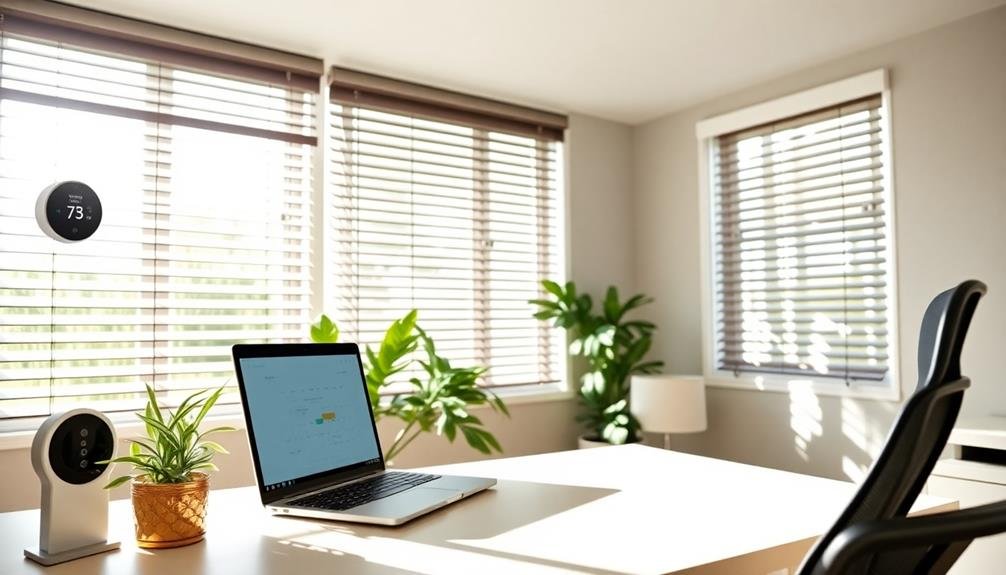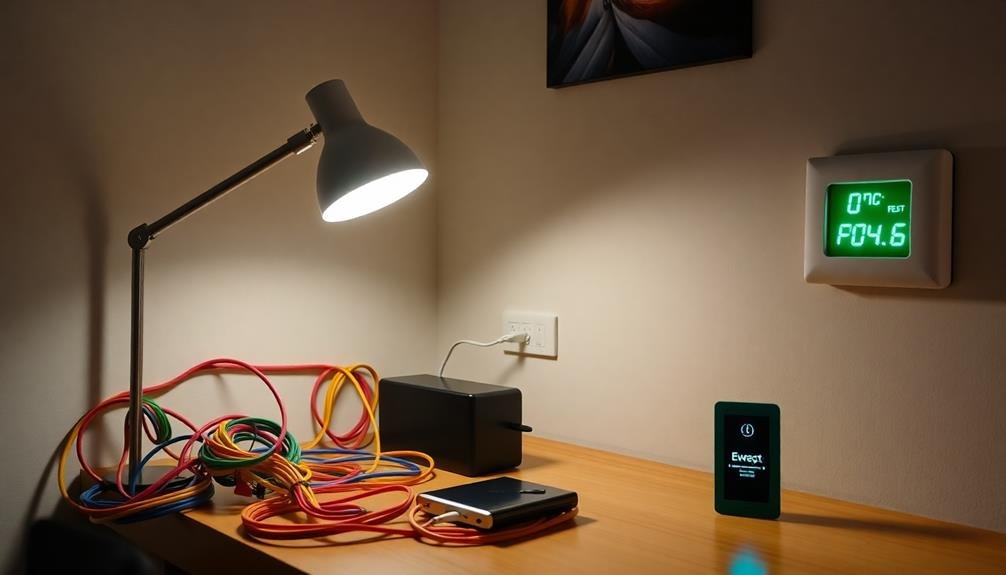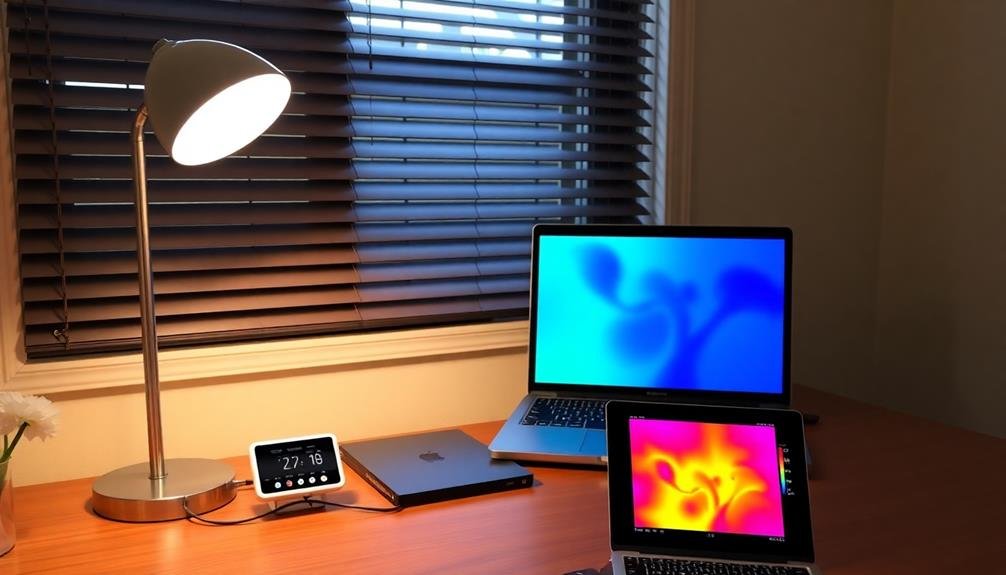To cut home office standby power, start by using smart power strips. These automatically shut off power to peripherals when your main device is turned off, reducing vampire energy drain. Next, unplug unused devices or use power strips with on/off switches for easy management. This habit can greatly lower your electricity bills. Finally, choose energy-efficient equipment like ENERGY STAR certified products, which consume less power overall. Opt for laptops, LED monitors, and USB-powered peripherals when possible. By implementing these strategies, you'll not only save money but also reduce your carbon footprint. There's even more you can do to maximize your energy savings.
Smart Power Strips

Slash your home office energy waste with smart power strips. These intelligent devices automatically cut power to peripherals when you turn off your main device, typically your computer. By doing so, they eliminate standby power consumption, also known as vampire power, which can account for up to 10% of your home's electricity use.
Smart power strips come in various types. Timer-equipped strips shut off power at preset times, ideal for consistent work schedules. Current-sensing strips detect when your computer enters sleep mode and cut power to connected devices. Motion-sensing strips use infrared technology to detect your presence, powering on when you're in the room and off when you leave.
To maximize efficiency, plug your computer into the strip's "control" outlet and connect peripherals like printers, speakers, and monitors to the "switched" outlets. Some strips also feature "always-on" outlets for devices that need constant power, such as routers or modems.
When shopping for a smart power strip, consider the number of outlets you need, surge protection features, and compatibility with your devices. By investing in this simple technology, you'll reduce your energy bills and shrink your carbon footprint.
Unplug Unused Devices
Tackle the energy vampires in your home office by unplugging devices you're not actively using. Many electronics continue to draw power even when they're turned off, contributing to unnecessary energy consumption and higher electricity bills. Identify the biggest culprits, such as printers, scanners, and charging docks, and unplug them when not in use.
Create a habit of unplugging devices at the end of your workday. This simple action can greatly reduce your standby power consumption. For items you use infrequently, consider keeping them unplugged until needed.
If you have multiple devices that you often use together, connect them to a power strip with an on/off switch for easy disconnection.
Be mindful of less obvious energy drains, such as Wi-Fi routers, modems, and smart home devices. While you may need to keep some of these powered on, evaluate which ones can be safely unplugged or powered down when you're not working.
For devices with built-in batteries, like laptops and tablets, unplug them once they're fully charged to avoid overcharging and wasting electricity.
Energy-Efficient Equipment Selection

While unplugging devices cuts standby power, choosing energy-efficient equipment from the start can greatly reduce your home office's overall energy consumption. When selecting new equipment, look for ENERGY STAR certified products. These devices meet strict energy efficiency guidelines set by the U.S. Environmental Protection Agency and the Department of Energy.
Consider the following energy-efficient options for your home office:
| Device Type | Energy-Efficient Choice | Potential Savings |
|---|---|---|
| Computer | Laptop or mini PC | Up to 80% less energy |
| Monitor | LED display | 65-70% less than LCD |
| Printer | Inkjet over laser | 90% less energy use |
When shopping for office equipment, compare the annual energy consumption of different models. This information is often available on product labels or manufacturer websites. Don't forget about peripherals like speakers, webcams, and external hard drives. Opt for USB-powered versions when possible, as they typically consume less energy than their AC-powered counterparts.
Frequently Asked Questions
How Much Can I Save Annually by Reducing Standby Power Consumption?
You can save $100 to $200 annually by reducing standby power consumption. It'll depend on your specific appliances and usage habits. Start unplugging devices when not in use and invest in smart power strips for easier management.
Are There Any Risks Associated With Completely Shutting off Electronic Devices?
There are some risks when completely shutting off electronic devices. You might lose unsaved data, disrupt software updates, or shorten device lifespan. It can also be inconvenient to wait for full reboots. Consider using power strips instead.
Which Home Office Devices Typically Consume the Most Standby Power?
You'll find that printers, desktop computers, monitors, and routers often consume the most standby power in your home office. Don't forget about charging stations, sound systems, and smart devices, which can also be significant power vampires.
How Can I Measure Standby Power Consumption in My Home Office?
You can measure standby power consumption in your home office using a plug-in power meter. Simply plug your device into the meter, then plug the meter into the wall outlet. It'll display the device's power draw.
Do Power-Saving Modes Effectively Reduce Standby Power Consumption?
Yes, power-saving modes can effectively reduce standby power consumption. They lower energy use when devices aren't in active use. However, you'll get the best results by combining power-saving modes with unplugging or using smart power strips.
In Summary
You've now got three powerful ways to slash your home office's standby power consumption. By using smart power strips, unplugging unused devices, and selecting energy-efficient equipment, you'll see a noticeable drop in your energy bills. Remember, every little bit counts. Start implementing these strategies today, and you'll not only save money but also reduce your carbon footprint. It's a win-win for your wallet and the environment. Keep up the energy-saving efforts!





Leave a Reply